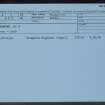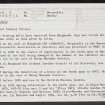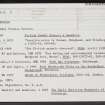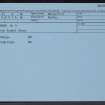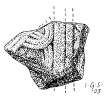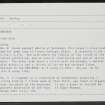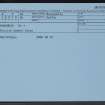Burghead
Cross Slab(S) (Pictish), Pictish Symbol Stone(S) (Pictish)
Site Name Burghead
Classification Cross Slab(S) (Pictish), Pictish Symbol Stone(S) (Pictish)
Canmore ID 16190
Site Number NJ16NW 5
NGR NJ 1088 6914
Datum OSGB36 - NGR
Permalink http://canmore.org.uk/site/16190
- Council Moray
- Parish Duffus
- Former Region Grampian
- Former District Moray
- Former County Morayshire
Burghead
The Morayshire promontory of Burghead was the location of a great Pictish fort, and the surviving sculpture implies that it had its own church and burial ground. The earliest are six blocks of stone each incised with a powerful image of a bull (nos 1-6), which are associated with the fort itself, as may be the ‘celtic head’ said to have been found in the great well in the lower enclosure of the fort. Sadly the sculpture to be associated with the church is a very fragmentary glimpse of what must have been an impressive collection of cross-slabs and at least one shrine-chest.
A Ritchie 2019
Reference (1997)
Six Class I symbol stones.
Burghead I : Class I symbol stone bearing a Bull. (NJ16NW 5.01)
Burghead 2 : Bull with damaged head (NJ16NW 5.02)
Burghead 3 : Bull(complete) (NJ16NW 5.03)
Burghead 4 : Bull with damaged body (NJ16NW 5.04)
Burghead 5 : in the British Museum (NJ16NW 5.05)
Burghead 6 : Bull with damaged body (NJ16NW 5.06)
A Mack 1997
External Reference (September 2003)
Early medieval sculpture additional to the above comprises:
No.10 Lost fragments bearing key-pattern (Allen and Anderson 1903, 139, 10 and 10a). Lost. ((NJ16NW 5.09)
No.12 Fragment of key-pattern (Allen and Anderson 1903, 140, 12). Lost. ((NJ16NW 5.10).
No.13 Fragment of key-pattern (Allen and Anderson 1903, 141, 13). Lost. (NJ16NW 5.11).
No.14 Fragment of key-pattern (Allen and Anderson 1903, 141, 14). Lost.(NJ16NW 5.12)
No.15 Celtic head (Foster 1996, fig.23). (NJ16NW 2.01)
No.16 Celtic head (British Library Additional Ms 37555 ff.298-back). Lost. (NJ16NW 5.13).
No.17 Fragment of interlace (Burghead Headland Trust). (NJ16NW 5.14).
See also NJ16NW 6.
Information from I G Scott, September 2003.
Desk Based Assessment
NJ16NW 5 1088 6914.
Six slabs bearing bulls have survived from Burghead; they are listed briefly here in the same order as that given by Allen and Anderson (1903).
1. Found in the well at Burghead (NJ 1102 6915). Originally in the Museum of the Scientific Association at Inverness and was presented to National Museum of Antiquities of Scotland [NMAS] in 1891 (IB 95).
2. Found in 1862 in the course of improvements to the South quay at Burghead; the head of the bull being damaged by the hammer of the labourer who found it. It is now in the care of Moray Museums Service.
3. Found at Burghead but without further details of its discovery, now in Elgin Museum.
4. Found during the demolition of a house at the South quay in 1867, this fragment is now in the care of Moray Museums Service.
5. Found before 1809 and now in the British Museum, London.
6. Found in 1854 during alterations to the South quay, now in Elgin Museum.
Information from OS.
A Mitchell 1874; J R Allen and J Anderson 19034; C A Gordon 1967; K J Edwards and I B M Ralston 1980; J Close-Brooks and R B K Stevenson 1982; I M Ralston and J Inglis 1984; RCAHMS 1985.
Note
For Allen and Anderson's No.7 and No.11, see NJ16NW 6.01 and NJ16NW 6.02 respectively.

















